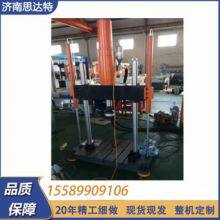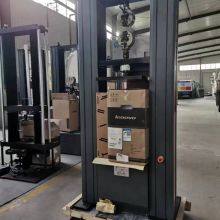A fatigue testing machine is a specialized device used to test the performance of materials and components under cyclic loads. Its working principle involves applying periodic loads to simulate the stress that materials or parts experience during repeated use, in order to detect their fatigue life and fatigue strength. The core components of a fatigue testing machine include the loading system, measurement system, and control system. The loading system is typically composed of electric, hydraulic, or pneumatic devices, which can provide stable and controllable alternating loads. The measurement system is used to monitor parameters such as the deformation, stress, and strain of the specimen, while the control system is responsible for the precise control of the entire testing process, ensuring the accuracy of the test results.
Fatigue testing machines have a wide range of applications, including but not limited to the following fields:
1. Metal Industry: Used to test the fatigue performance of metal materials, such as steel wires, manhole covers, springs, anchors, steel wire ropes, steel strands, cables, bolts, steel plates, and rebar.
2. Plastic and Rubber Industry: Used to test the fatigue performance of plastic and rubber products, such as plastic foams, films, tires, corrugated pipes, pipe fittings, hoses, and timing belts.
3. Automotive Industry: Used to test the fatigue performance of automotive components, such as shock absorbers, bearings, bushings, connecting rods, hubs, automotive chassis, parts, and automotive seats.
4. Aerospace Industry: Used to test the fatigue performance of materials and components of aircraft and spacecraft to ensure their safety and reliability under extreme conditions.
5. Electronics and Mechanical Industry: Used to test the fatigue performance of electronic and mechanical components, such as circuit boards, connectors, relays, motors, bearings, and gears.
6. Construction Industry: Used to test the fatigue performance of building materials, such as concrete, steel, and wood, to ensure the stability and safety of buildings during long-term use.
Depending on the driving method and driving unit, fatigue testing machines can be divided into various types, such as electromagnetic drive, electro-hydraulic servo drive, pneumatic drive, lever and centrifugal mechanism drive, and crank mechanism drive. Based on the test frequency, fatigue testing machines can be categorized into low-frequency, medium-frequency, high-frequency, and ultra-high-frequency fatigue testing machines. The technical parameters of fatigue testing machines include nominal load, static force, dynamic force amplitude, dynamic stroke, machine coaxiality accuracy, test frequency, static accuracy, and dynamic accuracy.
1. Host System:
- 1.1. Column spacing: ≥660mm.
- 1.2. Frame stiffness ≥770kN/mm.
- 1.3. Equipped with a hydraulic power lift and locking device for the crossbeam, the main column must be a fixed structure to guide the hydraulic lift crossbeam.
- 1.4. Features automatic protection functions for displacement and load, including shutting off the hydraulic pump station.
- 1.5. Static test force ≥600kN.
- 1.6. Dynamic test force ≥600kN.
- *1.7. Precision not lower than ±0.5% within the 2% to 100% load measurement range.
- 1.8. Uses a static pressure support or clearance seal actuator, with an actuator stroke of not less than ±75mm.
- *1.9. Built-in displacement sensor with a measurement precision not lower than ±0.2% FS.
- 1.10. Maximum test space: ≥1000mm.
- 1.11. Frequency range: 0.01Hz to 50Hz.
- *1.12. The equipment must be equipped with a centering device, with equipment coaxiality ≤5%.
2. Control System:
- 2.1. Control methods: Including displacement, load, and strain control methods, with amplitude control functionality.
- 2.2. Effective data acquisition frequency and closed-loop control frequency ≥10kHz.
- 2.3. Stiffness adaptive control system, which automatically sets load and strain PID parameters based on the stiffness of the specimen with one button, and continuously updates PID parameters at a frequency of 1kHz during the test to automatically compensate for changes in specimen stiffness.
- 2.4. Waveform signal generator: Sine wave, triangle wave, square wave, half sine wave, half triangle wave, half square wave, and ramp wave. It can also accept digital drive data downloaded from a computer or obtained from analog input.
- 2.5. Dynamic force transducer: The loading axis must be equipped with an accelerometer for inertial force compensation, with an overload resistance ≥300% and a lateral force resistance ≥40%.
- 2.6. The controller includes a handheld terminal that can move the actuator up and down, with a function to display the current status.
3. Hydraulic Oil Source System:
- *3.1. The hydraulic oil source system flow ≥200L/min, working pressure ≥21MPa.
- 3.2. Overall noise at a distance of one meter ≤65db.
- 3.3. The hydraulic power source has oil temperature alarm and hydraulic oil level insufficient alarm functions, using a constant pressure oil pump, integrated with a high-pressure filter, with a filter core ≤2μm.
- 3.4. Hydraulic control device, fully hydraulic control mode, no solenoid valve, crossbeam lift, lock/unlock control, to prevent sudden descent, with overspeed protection function.
4. Extensometer:
- 4.1. Adjustable gauge length extensometer: 1 piece, precision not lower than 0.5 grade, providing quick installation connection tools for rods, gauge lengths 12.5, 25, 50mm, travel ±5mm.
- 4.2. 100mm gauge length extensometer: 1 piece, precision not lower than 0.5 grade, maximum deformation 25%.
5. Cooling System (Chiller): Cooling power ≥30kW, when the cooling system is placed outdoors, it should include protective devices for outdoor facilities.
6. Software System:
- 6.1. A universal fatigue software package (including Chinese mode), containing high-cycle fatigue, low-cycle fatigue, and a complete set of static test software.
- 6.2. Equipped with a specimen temperature self-adaptive control module, which automatically adjusts the test frequency to maintain the specimen temperature at ≤40℃ as required by the standard.

Send Inquiry to This Supplier
You May Also Like
-
Electronic Universal Testing MachineUS$ 4000 - 5000MOQ: 1 Piece
-
Packaging Material Testing MachineUS$ 4000 - 5000MOQ: 1 Piece
-
Customized Horizontal Tensile Testing MachineUS$ 80000 - 100000MOQ: 1 Piece
-
Cup Extrusion Test MachineUS$ 9988 - 10000MOQ: 1 Bag
-
Manhole Cover Pressure Test MachineNegotiableMOQ: 1 Bag
-
Manhole Cover PressUS$ 9988 - 19888MOQ: 1 Bag
-
Electronic Universal Testing MachineUS$ 9988 - 19888MOQ: 1 Bag
-
Metal Bellows Testing MachineUS$ 1 - 9988MOQ: 1 Bag
-
Cupping Testing MachineUS$ 10000MOQ: 1 Pack
-
Dental Stone Compression Testing Machine,Dental Stone Bending Strength TestUS$ 9988MOQ: 1 Pack










